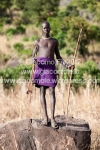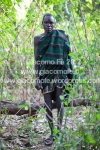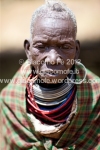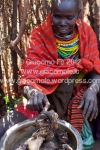Tepeth
The Tepeth are a tribal group estimated in 2010 to consist of roughly 16,000 people. They are part of the sub Nile population pushed to the mountains by the Karamojin population over the course of the last 20 years of civil war; when the latter received fire arms from the LRA (Lord’s Resistence Army). The Tepeth speak the Soo language and are a semi-nomadic tribe living in the village. They live in valleys and are divided according to family. The village where I stayed for this photo reportage is called Mushas (2350 meters) which is situated on a mountain range between 920 meters and 3048 meters high. The primary peak is Mount Moroto, on the border between Uganda and Kenya and where the Rift Valley is located.
Photography
My photogallery is based on photographs of work scenes, portraits, group pictures, food, meetings, and night images. While the Tepeth were not at all interested in photography, I observed the opposite with other Karamojin tribes (who were very interested in seeing their pictures on my display monitor). This is perhaps due to their having had more contact with tourists.
Hierarchy and Society
The social organization of the village provides for two shamans. This way if one shaman moves from the village the second shaman can replace him (as one shaman must always be present in the village). The shaman is responsible for making all of the tribal decisions. The villagers can make requests each week on Wednesdays and Fridays, after which a decision will be made. These meetings take place in the valley under a large tree. In general children work alongside the women or sheperds. The shamans can be identified by the scars on their skin, usually on their abdomen. These scars are considered votive signs. There is a local doctor who uses natural remedies that he procures from the forest as modern medicinal practices are unknown. The warriors\hunters control entry into the valley, defend the borders, and hunt Dik Dik (a little gazelle), birds and snakes. Their bodies are also covered with scars that testify to their bravery and the enemies they have killed. The farmers grow white corn which mixed with water creates a type of semolina that is the foundation of their diet. The shepherds are responsible for the breeding of sheep and goats that are killed and eaten if the hunt has not produced alternative meats. The water used to drink and to cook comes from wells dug in the forest and is carried to the huts in buckets. The tribe also breeds roosters and hens that are useful for the production of eggs and their meat. The women are responsible for the construction of the huts, water transport, and bartering local goods with nearby valley families (unfortunately this usually consists of bartering shirts).
Clothing and Ornaments
Women adorn their necks with numerous colored necklaces made up of beads that indicate their social provenance. The women also wear iron necklaces that are a symbol of their dowry. They also wear colored belts with fetishes and often a vial that contains a polverized plant that can be sniffed like a tobacco, but without narcotic effects. Their clothes consist of tissues, leather and bartered t-shirts.
School and Religion
Schooling is almost nonexistent and only present in some of the villages further down the valley. Of the many children I encountered in the village only one had a notebook. Some of the lower villages, those that belong to the Karamojin tribe, have encountered other religions, mainly christian or evangelical. However the village I visited has remained completely animistic like most of the Tepeth tribe. I did not see religious symbols worn by the villagers or in their homes. February 2012
TEPETH, STIME, LINGUA E POSIZIONE GEOGRAFICA
I Tepeth sono un ceppo tribale stimato nel 2010 a 16.000 persone ma le cifre sono assolutamente empiriche. Fa parte delle popolazioni sub nilotiche spinte sulle montagne dalle popolazioni Karamojin, soprattutto nell’ultimi 20 anni di guerra civile, quando questi ultimi hanno avuto le armi da fuoco per conto dell’LRA (Lord’s Resistence Army). La lingua parlata è il Soo. Sono tribù seminomadi, vivono in villaggi nelle valli divisi per famiglie. Il villaggio che mi ha ospitato nei giorni e nelle notti di fotografia si chiama Mushas (2350 mt)situato nella zona di montagne alte da 920mt a 3084mt, il cui monte principale è il monte Moroto, al confine tra Uganda e Kenia e in cui è situata la Rift Valley.
FOTOGRAFIA
La mia ricerca fotografica si è basata su scene di lavoro, ritrattistica, gruppi familiari, alimentazione, riunione, e immagini notturne.
GERARCHIA E SOCIALITA’
L’organizzazione sociale del villaggio prevede due sciamani perché se uno sciamano si muove dal villaggio il secondo prende il suo posto, uno sciamano deve essere sempre presente nel villaggio. Allo sciamano sono affidate le decisioni della tribù, vengono ascoltate le richieste del villaggio il mercoledì e il venerdì, e poi vengono prese le decisioni. Le riunioni hanno luogo sotto un grande albero nella valle, spesso in una piana. I bambini fanno i lavori più leggeri affiancando le donne o i pastori. Gli Sciamani portano sulla pelle, spesso sull’addome, cicatrici che sono segni votivi; un medico che usa rimedi naturali offerti dalla foresta poiché non conoscono medicine moderne; i guerrieri/cacciatori che controllano l’entrata della valle, difendono i confini, e cacciano Dik Dik, uccelli e serpenti, la pelle è segnata da cicatrici che testimoniano il valore e i nemici uccisi; i contadini che coltivano mais bianco, che una volta impastato con l’acqua diventa un tipo di semolino che è alla base della loro dieta; i pastori che si dedicano all’allevamento e al pascolo di piccole mandrie di pecore e capre che vengono uccise e mangiate nel caso la caccia non sia andata a buon fine. L’acqua che usano per cucinare e bere proviene da pozze scavate nella foresta e viene portata alle capanne con secchi o taniche. Allevano anche galli e galline da cui ottengono uova per l’alimentazione ed eventuale carne. Le donne si occupano della costruzione delle capanne, del trasporto dell’acqua e del baratto con le popolazioni della valle dei cereali prodotti, purtroppo sempre più spesso barattati con magliette.
ABITI E ORNAMENTI
Il collo delle donne è ornato da molte collane colorate fatte di perline che dimostrano la provenienza della donna e il ceto sociale a cui appartiene. Le donne indossano altresì alcune collane di ferro che stanno a significare l’ eventuale dote riscattata. Portano cinture colorate con feticci e spesso con una ampolla che contiene una pianta polverizzata che sniffano, simile a un tabacco da sniffo, senza alcun effetto stupefacente, usato durante le conversazioni. Gli abiti sono costituiti da stuole, pelli e all’occorrenza, usate come abito di pregio, t-shirt barattate.
SCOLARIZZAZIONE E RELIGIONE
La scolarizzazione è quasi inesistente e presente comunque solo in villaggi più a valle. Di tanti bambini incontrati nel villaggio, solo uno possedeva un quaderno. Alcuni villaggi nelle valli più basse, soprattutto delle popolazioni Karamojin, sono stati raggiunti da altre religioni, quali quella cristiana o evangelica, mentre il villaggio da me fotografato ha mantenuto una religione totalmente animista, come la maggior parte dei villaggi Tepeth. Non ho visto simboli religiosi nel indosso alle persone ne nelle abitazioni. febbraio 2012






















